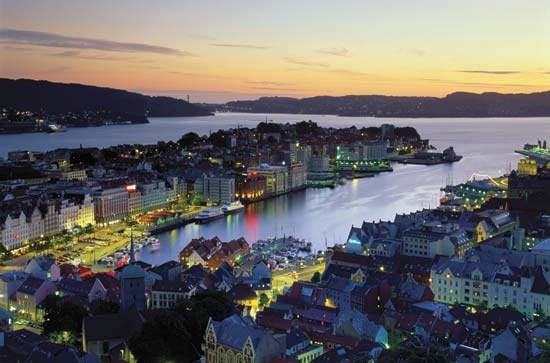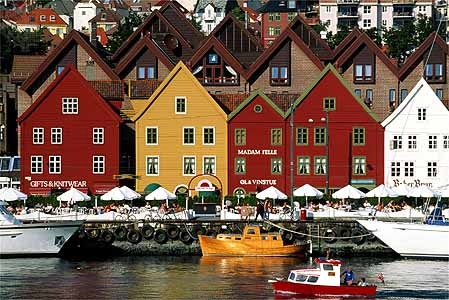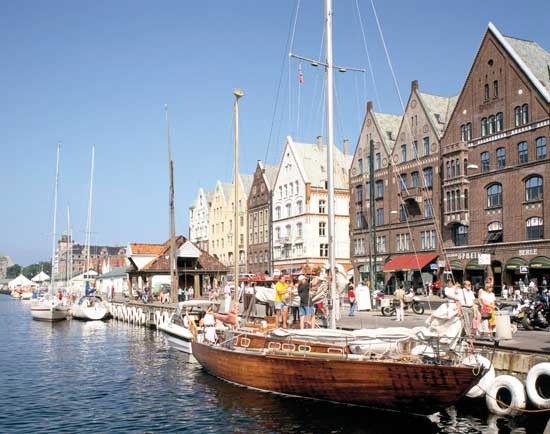Bergen
Norway
 city and port, southwestern Norway. The principal port and business section is on a peninsula projecting into By Fjord, bounded to the north by the inlet and harbour of Vågen (for small ships) and on the south by Pudde Bay (for larger vessels) and the Store Lungegårds Lake.
city and port, southwestern Norway. The principal port and business section is on a peninsula projecting into By Fjord, bounded to the north by the inlet and harbour of Vågen (for small ships) and on the south by Pudde Bay (for larger vessels) and the Store Lungegårds Lake.Originally called Bjørgvin, the city was founded in 1070 by King Olaf III Haraldsson. About 1100 a castle was built on the northern edge of Vågen harbour, and Bergen became commercially and politically important; it was Norway's capital in the 12th and 13th centuries. An episcopal see was established there in the 12th century. A trade centre for centuries, Bergen exported fish and furs and imported grain and manufactured goods. In the 14th century, German Hanseatic (Hanseatic League) merchants acquired control over the city's trade; their influence in a weakened Norway lasted into the 17th century. Bergen has remained the most important port on the west coast of Norway, despite its repeated destruction by fire (most notably in 1702 and 1916); wider streets and buildings of brick and stone have been built in response to these disasters.

 Bergen is now the second largest city in Norway. It has developed a diversified economy, based largely on fishing, shipbuilding and associated industries (repairing and equipment), machinery and metal products, and food processing. Tourism has also grown in importance. Notable buildings are the 12th-century St. Mary's Church, the city's oldest structure; Bergenhus fortress, including Håkonshallen (Haakon's Hall, built in the 13th century); and the Rosenkrantz Tower. The latter two buildings were severely damaged during the German occupation (1940–45). Bryggen, the city's historic harbour district, is notable for the wooden structures lining the waterfront; it was designated a UNESCO World Heritage site in 1979.
Bergen is now the second largest city in Norway. It has developed a diversified economy, based largely on fishing, shipbuilding and associated industries (repairing and equipment), machinery and metal products, and food processing. Tourism has also grown in importance. Notable buildings are the 12th-century St. Mary's Church, the city's oldest structure; Bergenhus fortress, including Håkonshallen (Haakon's Hall, built in the 13th century); and the Rosenkrantz Tower. The latter two buildings were severely damaged during the German occupation (1940–45). Bryggen, the city's historic harbour district, is notable for the wooden structures lining the waterfront; it was designated a UNESCO World Heritage site in 1979.Bergen is the seat of a university (1946) as well as of the Norwegian School of Economics and Business Administration (1936). Its West Norway Museum of Decorative Art (1887) has a fine collection. The well-known Bergen International Music Festival takes place each year. Bergen was the birthplace of composer Edvard Grieg (Grieg, Edvard), violinist Ole Bull (Bull, Ole), landscape painter Johan Christian Dahl, and dramatist Ludvig Holberg (Holberg, Ludvig, Friherre Holberg). Pop. (2007 est.) mun., 244,620.
county, New Jersey, United States
county, northeastern New Jersey, U.S., bordered by New York state to the north and east, the Hudson River constituting the eastern boundary. Its topography consists of a hilly piedmont region that rises to the Watchung Mountains in the west and includes the Palisades, sheer sandstone bluffs along the edge of the Hudson River. The county is drained by the Hackensack, Passaic (Passaic River), and Ramapo rivers. Other waterways are Lake Tappan and Oradell Reservoir. Oak and hickory trees are found in wooded areas. The main recreation areas are Ramapo Mountain State Forest and Ringwood State Park.
Algonquian-speaking Indians inhabited the region before the arrival of Dutch and English settlers in the 17th century. Bergen, one of the original New Jersey counties, was formed in 1683 and named for Bergen op Zoom, Neth. In November 1776, Americans abandoned Fort Lee on the Hudson to its British attackers during the U.S. War of Independence (American Revolution). For the first two decades of the 20th century, the borough of Fort Lee was a major motion picture capital. The Teaneck-Hackensack campus of Fairleigh Dickinson University (founded 1942) was established in 1954. The Meadowlands Sports Complex in East Rutherford is the home of professional sports teams from both New Jersey and New York City.
Because of its proximity to New York City and Newark, Bergen county is the most populous county in the state. The principal communities are Teaneck, Hackensack (the county seat), Fort Lee, Fair Lawn, Garfield, Paramus, and Englewood. The primary economic activities are services (business and health), manufacturing (printing, chemicals, and surgical supplies), and trade (retail and wholesale). Area 234 square miles (607 square km). Pop. (2000) 884,118; (2007 est.) 895,744.
- aril
- Ariminum, Council of
- Arinnitti
- Arinos River
- Ariobarzanes
- Arion
- Ariosto, Ludovico
- Arisaema
- Arishima Takeo
- Arishtanemi
- Aristaeus
- Aristagoras
- aristarch
- Aristarchus Of Samos
- Aristarchus Of Samothrace
- Aristeas, Letter of
- Aristide Briand
- Aristide Cavaillé-Coll
- Aristide, Jean-Bertrand
- Aristide Maillol
- Aristides
- Aristides Agramonte y Simoni
- Aristides Quintilianus
- Aristides The Just
- Aristippus